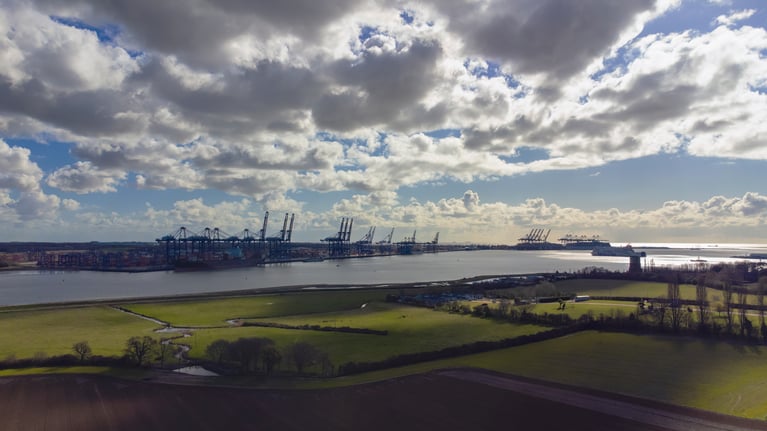In 2024, the ongoing Red Sea crisis has served as a severe reminder of business’ exposure to geopolitics and highlighted the importance of risk management strategies.
Merchant traffic through the region is estimated to be 66% down on typical levels, as a consequence of Houthi-rebels in Yemen firing missiles at transiting ships. 19,000 vessels move between the Indian Ocean and Mediterranean Sea every year, so if the diversion persists, up to 12,700 could be diverting around the Cape of Good Hope in 2024.
Businesses, particularly across Europe, have been exposed to surging supply chain costs as result of this diversion.
The world grows increasingly unstable. Climate change threatens maritime transport with aggressive weather patterns. Storms and flooding can disrupt trading routes and port operations. Geopolitics presents all kinds of threats, through conflicts to tariffs. Pandemics can appear from nowhere with the most unexpected but devastating consequences.
The question around building resilience into a supply chain has never been more critical. Companies worldwide are being forced to re-evaluate their approach to international trade.
Research has shown that adopting several strategies can reduce the impact disruption has on your business’ supply chain.
“Companies can effectively manage supply-chain risks by identifying weak links and implementing mitigation strategies, such as "stress testing," to avoid disruptions and maximise profits.”
Chopra, S., & Sodhi, M. (2004). Managing Risk to Avoid Supply-Chain Breakdown.
This article explores some key lessons that businesses can take from the Red Sea crisis. It will provide insights into how you can adapt your logistics to mitigate risks, enhance resilience, and thrive in this uncertain global environment.
Lesson 1: Increased focus on risk management and contingency planning.
In the busy supply chain environment, it can be difficult to find time for building risk management strategies and contingency planning. But in this world of heightened risk, it’s an extremely good use of time and certainly a lesson to take from the Red Sea crisis.
Businesses need to invest in robust risk management strategies to navigate geopolitical uncertainties effectively. This includes scenario planning, geopolitical relationship analysis, and if financially viable, insurance coverage tailored to mitigate. Below we have built a template for writing a strong risk management strategy.
Risk management strategy template:
Outline Goals
- Explain of the significance of supply chain risk management in mitigating disruptions and enhancing operational efficiency.
- Overview of the purpose and scope of the strategy for other executives.
Risk Identification and Assessment
- Forensically assess your supply chain for possible risks to disruption across all stages and list these.
- Potentially use an AI model, such as Google Gemini or Chat GPT, to assist with identifying where risks lie in your supply chain (example prompt below).
- Rank these risks in terms of their severity and likelihood, using tools such as a risk matrix, scenario analysis, and historical data.
Example prompt for AI to identify supply chain risks:
“My business is shipping [TYPE OF CARGO] goods using [TRANSPORTATION OPTIONS] between [OUTLINE IMPORT AND EXPORT PORTFOLIO]. We also have the following extra provisions as part of our supply chain; [EXTRA PROVISIONS]. Please outline all the possible supply chain risks your research suggests we are exposed to and that we need to contingency plan for.”
Risk Mitigation Strategies
- Develop risk mitigation strategies tailored to address identified risks.
- Outline a plan for implementation of each, including any collaboration required with suppliers, partners and stakeholders, including regular testing of contingency plans.
Supplier Relationship Management
- Outline plan to integrate risk management considerations into supplier contracts and agreements.
- Reconsider communication arrangements with suppliers if necessary.
Technology and Data Management
- Use of technology solutions for real-time monitoring, tracking, and analysis of supply chain activities – such as the WTA Platform.
- Integrate supply chain risk management tools and platforms to enhance visibility and decision-making capabilities.
Performance Measurement and Continuous Improvement
- Define key performance indicators (KPIs) to measure the effectiveness of the risk management strategy.
- Regular assessment and review of supply chain performance against established KPIs.
- Implementation of feedback mechanisms and lessons learned sessions to drive continuous improvement.
Training and Awareness
- Outline scope and budget for training programs and resources to educate employees and stakeholders about supply chain risks and mitigation strategies.
- Cultivation of a risk-aware culture that encourages proactive identification and management of risks at all levels of the organisation.
A detailed and well-considered risk management strategy following this template means that you’re well prepared in the event of a crisis such as the Red Sea disruption, and have a contingency plan in place to mitigate.
The key value in these plans is taking the time to consider as many disruptors as possible. Obviously, there is an infinite number of potential external impactors on your supply chain, but covering a range of scenarios means even if the exact thing you planned for doesn’t happen, one of your contingency plans could be a good fit.

Lesson 2: Enhance supply chain visibility
Building visibility across your supply chain is a hugely significant way to mitigate disruptions such as the Red Sea crisis. There’s a reason 77% of surveyed companies considered it a top priority in 2021.
Supply chain visibility protects against disruptions in a whole host of ways. Research shows companies who have visibility across their supply chain perform better. Right now it can be considered a genuine competitive advantage. Here are some of the ways a visibility tool leaves you better prepared against disruption:
- Real-time location: See exactly where your goods are at all times. This means you aren’t waiting for communication from a third-party. You can locate them immediately and see if they’re impacted.
- Better communication: Features such as live chat improve communication with all supply chain stakeholders. More succinct communication will only improve supply chain functionality when disaster strikes.
- Delay notifications: Receiving automatic notifications of delays or expected additional charges means your budgeting and customer communication is the best it can be.
- Inventory optimisation: AI within visibility tools can use historical data to recommend optimum inventory levels. That means potential delays are accounted for and there’s no stock level crisis.
- Route optimisation: Map out several possible routes for cargo to take, meaning disruption on a particular trade lane could be avoided.
- CO2 emission tracking: See the environmental cost of disruption to your supply chain, meaning you can more accurately forecast any costs associated with that.
- Temperature and condition monitoring: For perishable goods, observe the temperature, humidity, lighting and shock conditions of your freight throughout transit, so you know if disruption will have harmed their condition.
Tools such as the WTA Platform deliver all this data to mitigate supply chain risk at no cost for our customers. Access live location of containers and all data points, including cost and timing information, with a simple log in. Process your trade documents electronically, saving time, postage and environmental costs.
“I love the WTA Platform’s live chat feature. We pride ourselves on our quality of service and having that immediate chat option, alongside a dedicated point of contact, gives us a really personal edge.”
Liam Launders, Head of Sales, WTA
Lesson 3: Supplier diversification
Although this is a difficult strategy to implement for many businesses, particularly those importing from China into Europe, it’s worth exploring as a lesson from the Red Sea crisis. Because it’s an extremely effective way to negate the trouble.
If your business can separately procure from another destination, such as Eastern Europe or perhaps South America, you would be largely protected from the disruption that has been created by conflict in the Red Sea.
Although there will have been some additional costs as freight rates tick upwards across almost all trade lanes, trouble would be minimised.
However, admittedly this is a difficult strategy to implement for many businesses. Such is the complexity of supply chains, it might not be possible to procure the right quality goods at the right price and in sufficient quantities.
Additionally, supply lines are extraordinarily complex. The idea of sourcing backup suppliers, storage facilities, and potentially contract agreements with freight forwarders or carriers, could be an impossibly big task.
For more information on supplier diversification or consolidation, see our separate article here.
Unfortunately, there are no lessons which make it 100% certain events like the Red Sea crisis do not impact your supply chain. It’s about building layers of defence. That means fewer events are damaging for you and if they do sneak through, the disruption they cause will be less widespread.

The Red Sea crisis, like the pandemic before it, has cast another spotlight on the vulnerabilities in global supply chains. Business leaders need to learn from these experiences and take proactive action to mitigate potential threats ahead.
Enhancing supply chain visibility emerges as a key strategy. Real-time monitoring and predictive analytics can swiftly identify and address disruptions. Likewise, detailed risk management and contingency planning are the best way to plan for vulnerabilities.
Yet, amidst these key takeaways lies a broader realisation: within the complexity of supply chain management there are an endless array of strategies for mitigating disruption. While these lessons offer a solid foundation, it's essential to acknowledge that each business's supply chain is unique. Only through internal assessment can business leaders effectively fortify their supply chains, build resilience and assist readiness to navigate the uncertainties of global trade.
Speak to WTA about building resilience into your supply chain.









